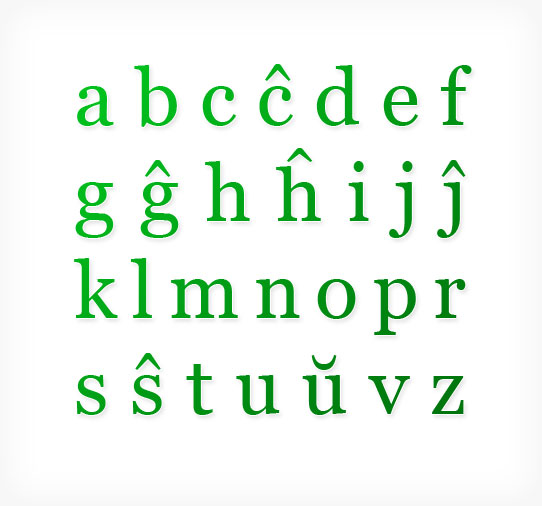Quick Esperanto pronunciation guide for English speakers Posted by Chuck Smith on May 23, 2011 in Esperanto Language
Do you know someone who needs to be able to read an Esperanto text aloud, but doesn’t speak Esperanto? Perhaps, they want to read a speech at an Esperanto conference or perhaps you want to play an Esperanto part in a play or movie? Maybe you just want to impress your friends with your mad language skillz? I’m going to show you how to pronounce Esperanto in one quick, easy lesson. The Esperanto alphabet does not have q, w, x, or y. Instead, it includes the letters ĉ, ĝ, ĥ, ĵ, ŝ and ü.
I would recommend taking the time now to listen to the entire alphabet on lernu.net to get a general feel for the letters. Note that when saying a letter, it is simply the sound for vowels and the sound followed by o for consonants. Thus the beginning of the alphabet sounds like ah, bo, tso, cho, doh, eh.
Now, you might be wondering, why add special characters? Well, when Zamenhof was creating Esperanto, he had no problem typing any of these letters on his typewriter. I don’t think anyone could have imagined that technology would “evolve” in such a way that it would no longer be possible to easily type them. You’ll notice in English that there are many ways to pronounce the same written letters. Notice the classic example of ough. If you had never learned English, how would you now how to pronounce cough, tough, though and thought. I especially like the city of Loughborough, England. How do you pronounce it?! Unless you’re from England, you probably have no idea! The first ough like tough, last like though… yes, pronounced different in the same word!
He added these extra characters, so that each letter can only have exactly one way to pronounce it. Not only that, but the stress of each word always falls on the next-to-last syllable. That means if you see an Esperanto word, you always know how to pronounce it! Well, that is once you learn the letters, but as an English speaker, you already know how to pronounce quite a lot of them already. The following are obvious: b, d, f, h, k, l, m, n, p, s, t, v, and z. Now, let’s look at the rest.
Those vowels
a like ah
e like net
i like meet
o like hope
u like boot
Note that these should be pure vowel sounds, which can be difficult for English speakers.
The consonants
c like bats (remember this one!)
g like got
j like year
r similar to the Spanish r (you can pronounce it like the English r and be understood, you may just be laughed at)
Consonants with hats
ĉ like chat
ĝlike giant
ĥ like the Scottish loch (a bit hard to master, but fortunately it’s a pretty rare letter in modern Esperanto)
ĵ like pleasure
ŝ like sh
The letter ŭ
That just leaves ŭ. You will usually find this letter in one of the following combinations: aŭ and eŭ.
aŭ like how
eŭ like Elmer Fudd’s “vewy vewy cewfuw” (very, very careful)
In those rare cases where ŭ is used at the beginning of a word, just consider it a w.
Now, please listen to the entire alphabet again. If you’re doing a recording, it would really be best to make sure someone can check your pronunciation as it can be easy to forget a letter as you’re recording an entire text for the first time.
Special thanks to Tanja Borzel for creating the alphabet graphic above especially for this post! Note that since it is under the Creative Commons Attribution-ShareAlike 3.0 license, you may use and modify this image given that you publish this image under the same license in your works.

Build vocabulary, practice pronunciation, and more with Transparent Language Online. Available anytime, anywhere, on any device.
About the Author: Chuck Smith
I was born in the US, but Esperanto has led me all over the world. I started teaching myself Esperanto on a whim in 2001, not knowing how it would change my life. The timing couldn’t have been better; around that same time I discovered Wikipedia in it’s very early stages and launched the Esperanto version. When I decided to backpack through Europe, I found Esperanto speakers to host me. These connections led me to the Esperanto Youth Organization in Rotterdam, where I worked for a year, using Esperanto as my primary language. Though in recent years I’ve moved on to other endeavors like iOS development, I remain deeply engrained in the Esperanto community, and love keeping you informed of the latest news. The best thing that came from learning Esperanto has been the opportunity to connect with fellow speakers around the globe, so feel free to join in the conversation with a comment! I am now the founder and CTO of the social app Amikumu.





Comments:
Anne Bearheart:
Where is the emphasis/what syllable is emphasized?
Bill Frampton:
Emphasis is always on the second-last syllable, without exception.
Chanelle Wiggins:
How do you pronounce loch and the Spanish r
Chuck Smith:
@Chanelle Wiggins You can hear them here: http://en.lernu.net/enkonduko/lingvoprezento/alfabeto.php
Chris:
The only one that I’m not sure about is “eux”. That seems to vary according to various sites. Duolingo and you both suggest /eə/ But elsewhere people suggest /ju/ or even /əu/.
I think I’ll follow you and Duo.
John:
@Chris
Theoretically eŭ should be the diphthong [eu] in IPA, but I think in practice it’s usually closer to [eʊ ~ ɛʊ], or something similar.
shimke:
very helpful. brief, clear and to the point.
Romi:
Does double L have a different pronunciation from a single L, like in Spanish? For example in the word “ajillo” ?
notphil:
@Romi no.